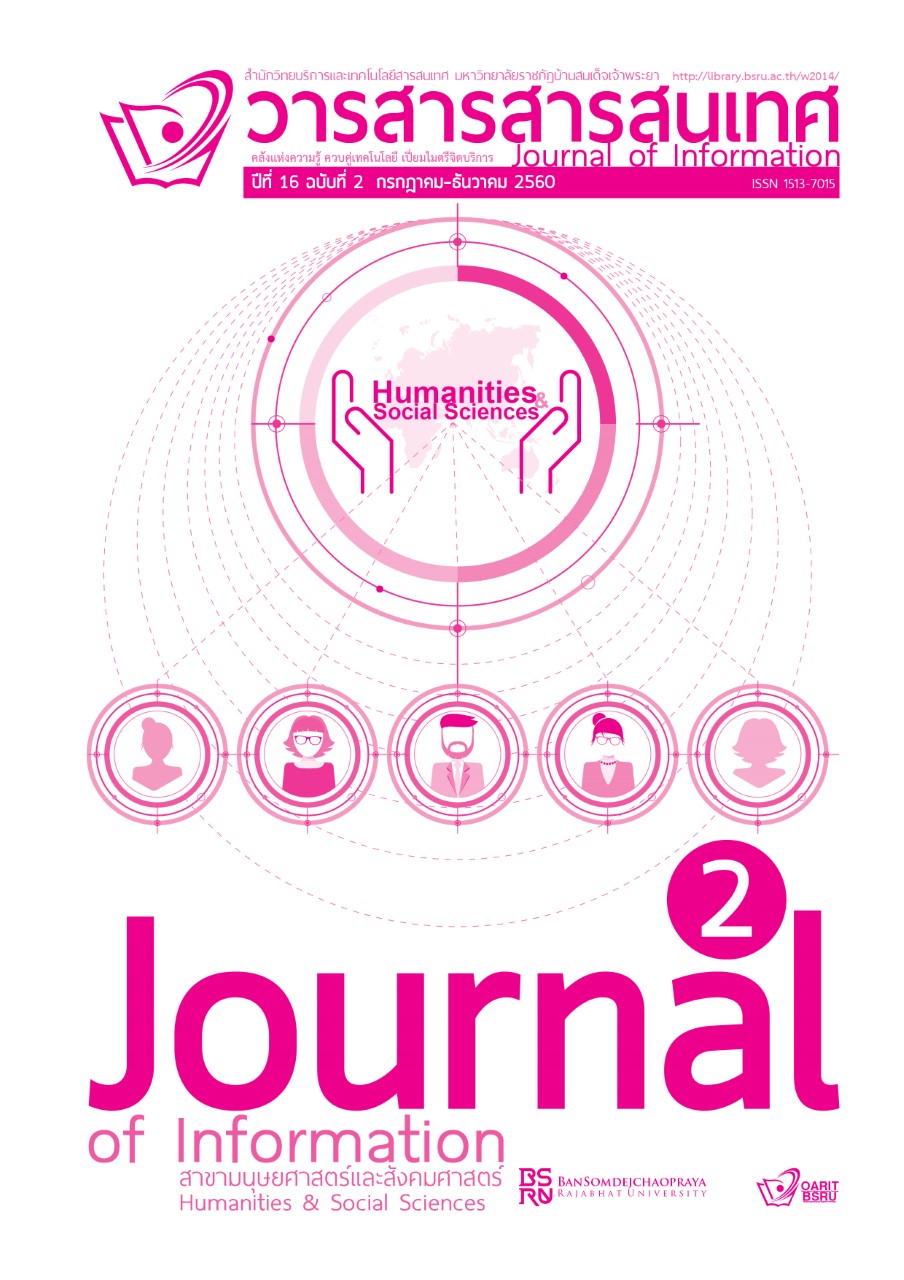พิธีกรรมและการแสดงในการขอฝนของวัฒนธรรมอีสาน : Rainmaking Rituals and Performances in the Northeastern Culture
Keywords:
พิธีกรรม, การแสดง, การขอฝน, วัฒนธรรมอีสานAbstract
บทคัดย่อ
วิทยานิพนธ์ เรื่อง พิธีกรรมและการแสดงในการขอฝนของวัฒนธรรมอีสาน มีวัตถุประสงค์เพื่อ 1) ศึกษาวิถีชีวิตที่เกี่ยวข้องกับความเชื่อและอาชีพเกษตรกรรม 2) ศึกษาที่มาและองค์ประกอบของพิธีกรรมการแสดงในการขอฝน 3) วิเคราะห์รูปแบบการแสดงและโครงสร้างท่ารำในพิธีกรรมขอฝน โดยใช้การวิจัยเชิงคุณภาพด้วยการศึกษาจากเอกสาร การลงภาคสนามเพื่อสัมภาษณ์ สังเกตและประชุมกลุ่มเกี่ยวกับพิธีกรรม และการแสดงขอฝนของหมู่บ้านหนองไหล ตำบลสร้างถ่อน้อย อำเภอหัวตะพาน จังหวัดอำนาจเจริญ
ผลการศึกษา พบว่า 1) ชาวอีสานมีวิถีการดำรงชีวิตที่ผูกพันกับความเชื่อของมนุษย์ที่มีต่ออำนาจลึกลับ และเชื่อมโยงกับความเชื่อในเรื่องภูตผีวิญญาณและพญาแถนซึ่งเป็นเทวดาที่ดลบันดาลให้ฝนตกต้องตามฤดูกาล 2) ที่มาและองค์ประกอบพิธีกรรมการขอฝนมีการเปลี่ยนแปลงตามยุคสมัย เช่น พิธีแห่บั้งไฟยังดำรงสืบต่อมาอย่างเข้มข้น เนื่องจากมีบรรจุไว้ในฮีตของชาวอีสาน ส่วนพิธีแห่นางแมวและพิธีเต้านางด้งคลายความนิยมลงไป 3) รูปแบบการแสดงและโครงสร้างท่ารำในพิธีกรรมขอฝนของหมู่บ้านหนองไหล พิธีแห่บั้งไฟ มีรูปแบบการแสดง 2 แบบ คือ แบบดั้งเดิมปรากฏ ท่ารำ 3 ท่า ร่ายรำไปตามจังหวะกลองตุ้ม และแบบพัฒนาปรากฏกระบวนท่ารำ 12 ท่า โดยนำรูปแบบท่ารำมาจากฟ้อนแม่บทอีสาน ร่ายรำไปตามทำนองดนตรีที่บรรเลงโดยวงดนตรีพื้นเมืองอีสานส่วนพิธีแห่นางแมว ไม่มีรูปแบบการแสดงที่เป็นแบบแผนรูปแบบท่ารำเกิดจากทักษะภูมิรู้ในการร่ายรำเฉพาะบุคคลและแห่ไปตามบ้านของคนในหมู่บ้าน ครั้นพอถึงบ้านใครก็จะเอาน้ำสาดใส่นางแมว และพิธีเต้านางด้ง มีรูปแบบการแสดง 2 แบบ คือ แบบดั้งเดิมไม่ปรากฏรูปแบบท่ารำและแบบพัฒนามีการประดิษฐ์รูปแบบท่ารำประกอบคำเซิ้ง พิธีแห่นางแมวและพิธีเต้านางด้ง อันสัมพันธ์กับการแสดงของหมู่บ้านหนองไหล จะสูญหายในอนาคตเพราะขาดการเอาใจใส่ดูแลและการสืบทอดจากเยาวชนของหมู่บ้าน
Abstract
The thesis on rainmaking rituals and performances in the Thai Northeastern culture during rainfall season aims to: 1) study the way of life related to beliefs and farming occupations; 2) study the origins and elements of the rituals in the rainmaking performances; 3) analyze the dance form and the dance movements structure of the rainmaking rituals and performances. The research was done using a qualitative method by studying related documents and field studies for meetings and interviews. The researcher observed the rituals and the rainmaking performances in the village of Nong Lai in Tambon Sang Tho Noi Hua Taphan District Amnatcharoen Province.
The study found that: 1) Isan people have a way of life that is linked to human beliefs in mysterious powers and spirits, such as the god Phayathen, who is the god of rainmaking. 2) The origin and composition of the ritual for rainmaking has changed according to the different generations. 3) The performance and the dance movements structure in the rainmaking ritual of Nong Lai village is known as the firework ceremony. There are two types of performance: traditional and neo-traditional. The traditional style has 3 dance movements, which follow the drumbeat. The neo-traditional style has 12 dance movements inspired by the Isan traditional dances. There aren’t any planned structures for the performances. The dance patterns and movements depend on the personal skills of the dancers, who dance around the village, going door to door. When, the dancers reach a home, the occupants would water Nang Maew. As for the Nang Dong ritual, there are 2 forms of performances: traditional, which isn’t performed anymore and neo-traditional.
The rituals Nang Maew and Nang Dong related to the performances of the village of Nong Lai will be lost in the future due to the lack of care and interest from the new generations of the village for this cultural legacy.
Downloads
Published
How to Cite
Issue
Section
License
บทความ ข้อความ ภาพประกอบ และตารางประกอบที่ลงพิมพ์ในวารสารเป็นความคิดเห็นส่วนตัวของผู้นิพนธ์ กองบรรณาธิการไม่จำเป็นต้องเห็นตามเสมอไป และไม่มีส่วนรับผิดชอบใดๆ ถือเป็นความรับผิดชอบของผู้นิพนธ์เพียงผู้เดียว






